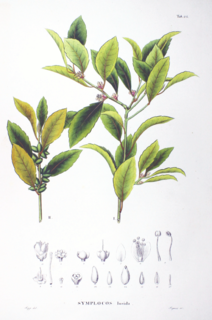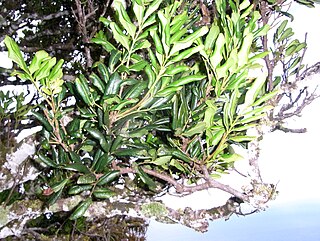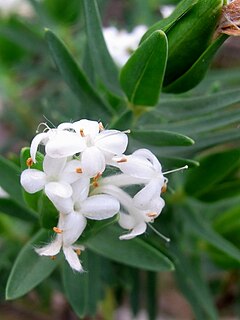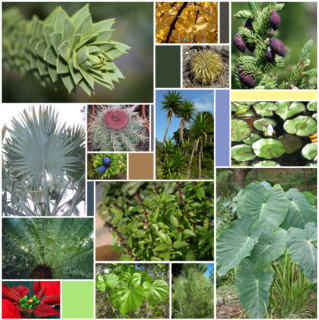
Symplocos is a genus of flowering plants in the order Ericales. It contains about 300 species distributed in Asia and the Americas. Many species grow in humid tropical regions. This is sometimes considered to be the only genus in family Symplocaceae. Plants in this family are shrubs and trees with white or yellow flowers.

Melaleuca howeana, commonly known as tea tree, is a plant in the myrtle family, Myrtaceae and is endemic to the Lord Howe Island group, 600 km (400 mi) off the east coast of Australia. It is common in exposed areas, on cliffs and ridges, occasionally forming pure stands. Its closest mainland relative is Melaleuca ericifolia.
Trophis scandens subsp. megacarpa is a flowering plant in the mulberry family. The subspecific epithet comes from the Greek mega ("big") and carpos ("fruit"), with reference to the larger fruits in this subspecies.

Polyscias cissodendron, commonly known as the Island Pine, is a species of tree in the ivy family, Araliaceae. It is native to New Caledonia and Vanuatu in Melanesia, as well as to Australia’s subtropical Lord Howe Island in the Tasman Sea. The specific epithet is derived from the Greek kissos (“ivy”) and dendron (“tree”). On Lord Howe it occurs in sheltered lowland forest.
Metrosideros sclerocarpa, commonly known as the mountain rose, is a flowering plant in the myrtle family. The specific epithet comes from the Greek scleros (“hard”) and karpos (“fruit”), with reference to the woody fruit.

Macropiper hooglandii , commonly known as Kava, is a flowering plant in the pepper family. The specific epithet honours Dutch botanist Ruurd Dirk Hoogland.
Coprosma huttoniana is a flowering plant in the coffee family. The specific epithet honours Ian Hutton, the Lord Howe Island based naturalist who discovered the plant and recognised it as a new species.
Coprosma lanceolaris is a flowering plant in the coffee family. The specific epithet comes from the Latin lancea with the suffix -aris, alluding to the shape of the leaves.

Coprosma putida, commonly known as Stinkwood, is a flowering plant in the coffee family. The specific epithet comes from the Latin puteo, alluding to the stench produced when the species is cut or bruised, including the leaves and fruit.
Psychotria carronis, commonly known as the Black Grape, is a flowering plant in the coffee family. The specific epithet honours William Carron (1823–1876) who collected plants on Lord Howe Island for the Royal Botanic Gardens, Sydney.
Melicope contermina is a flowering plant in the citrus family. The specific epithet comes from the Latin con (“with”) and terminus (“end”), with reference to the styles being joined at their ends.
Melicope polybotrya is a flowering plant in the citrus family. The specific epithet comes from the Greek polys (“many”) and botrys (“bunch”), referring to the clusters of flowers in the type specimen.
Exocarpos homalocladus, commonly known as the Grass Tree, is a flowering plant in the sandalwood family. The specific epithet comes from the Greek homalos (“flat”) and clados, with reference to the structure of the plant.

Guioa coriacea , commonly known as cedar or island cedar, is a flowering plant in the family Sapindaceae. The specific epithet refers to the coriaceous (leathery) leaves.

Pimelea congesta is a flowering plant in the Thymelaeaceae family. The specific epithet refers to the congested inflorescence.
Melicytus novae-zelandiae subsp. centurionis is a flowering plant in the violet family. It is a subspecies of Melicytus novae-zelandiae, known in New Zealand as coastal mahoe. The subspecific epithet honours the military Captain James Doran McComish (1881–1948), who made several visits in the 1930s to collect plants on Lord Howe Island.

Olearia elliptica subsp. praetermissa is a flowering plant in the daisy family. The subspecific epithet means "overlooked", referring to the fact that this distinctive endemic subspecies was long overlooked.
Leptospermum polygalifolium subsp. howense, commonly known as tea tree or tea-tree, is a flowering plant in the myrtle family, Myrtaceae. The subspecific epithet refers to the island to which the subspecies is endemic.
Macropiper excelsum subsp. psittacorum, commonly known as pepper tree or kava, is a flowering plant in the pepper family. The subspecific epithet means “of the parrots”, inferring a liking by parrots for the fruits.
Pouteria myrsinoides subsp. reticulata, commonly known as axe-handle wood, is a flowering plant in the sapodilla family, Sapotaceae. The subspecific epithet refers to the reticulate venation on the leaves.














